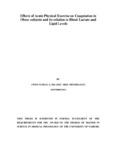| dc.description.abstract | BACKGROUND
Long term physical activity is beneficial in reduction of both body weight as well as attendant death from cardiovascular diseases. However activation of haemostasis has been reported in laboratory analysis after intense physical activity. This incongruence between benefit of long term physical exercise and laboratory coagulation analysis probably arises from studies carried out in plasma, and not whole blood in isolation. Furher the studies did not correlate test results to lactate and lipid levels which are both raised during exercise.
Objective: The aim of the present study was to investigate the effect of acute physical activity on blood coagulation in obese and non obese individuals, correlating with changes in lactate and lipid profiles.
SETTING: Medical Physiology Department, Kenyatta University, Nairobi
MATERIALS and METHODS
Obese and control groups (10 individuals in each group, 5 females and 5 males ), aged 18 to 39 years were recruited after signing written consent. Anthropometric data which included height, weight, abdominal circumference, wrist circumference and BMI were taken for each subject. The subjects underwent Harvard step test exercise for 5 minutes. Venous blood collection, haemodynamic measurements and electrocardiography were carried out at baseline before, within 1 minute after and 45 minutes after exercise. Laboratory tests were carried out for each subject. These tests were haemogram, lipid
2
profile, blood gas analysis, coagulation by routine and thromboelestography tests for all blood samples. Data were analyzed using independent t- test, correlation analysis and repeated measures ANOVA. Results were expressed as mean ± SD. The statistical difference was considered significant at P < 0.05.
RESULTS
Mean BMI for obese individuals was 33.6 while non-obese was 21.1. Acute physical activity was associated with increase in haemodynamic measurements, blood lactate and blood lipids, which returned to baseline values concurrently. However, no statistical differences were seen for lactate between the two groups at rest (1.66 ±1.37(C) vs. 1.06±0.62 (T), within 1 minute after exercise (8.24 ±2.47(C) vs. 9.21±1.50 (T) and at time of recovery (3.15 ±1.56(C) vs. 4.00±3.00 (T).The levels of LDL equally showed statistical significance across time in the two groups. Baseline means were (2.08±0.53(C) vs. 2.72±0.42(T)) (p=0.008) at rest, (2.23±0.69(C) vs2.93± 0.33(T)) (p=0.012) after exercise ,(2.000±0.537 vs. 2.730±0.435) (p=0.004) at time of recovery. Routine coagulation, serum based tests did not change significantly, but whole blood based thromboelastographic maximum amplitude changed significantly with time and between the subjects(p<0.005).
There was no correlation between blood lactate and routine coagulation in the experimental group. Lactate levels correlated positively with R value (r (10) =0.75, P<0.01) at 45 minutes. While there was negative correlation between lactate and G value (r (10) =-0.68, p <0.03.) Correlation of lipid profile and coagulation were not statistically significant for LDL and Cholesterol ratio.
3
CONCLUSION
Lactate and lipid levels were shown to increase after exercise and returned to normal at rest in both the obese and non obese subjects. However the changes in the two did not have a linear correlation with routine coagulation indicators as well as thromboelestography. Thus, the study concludes that lactate cannot be used as a predictor for development of hypercoagulabilty in vivo leading to an increased risk of thrombus formation. Likewise, lack of significant correlation between changes in lipid profile, especially LDL, cannot explain the differences seen thus far in coagulation after exercise. Demonstration of coagulation changes in whole blood, but not in plasma following acute physical activity warrants further investigation. | en_US |
| dc.description.department | a
Department of Psychiatry, University of Nairobi, ; bDepartment of Mental Health, School of Medicine,
Moi University, Eldoret, Kenya | |



